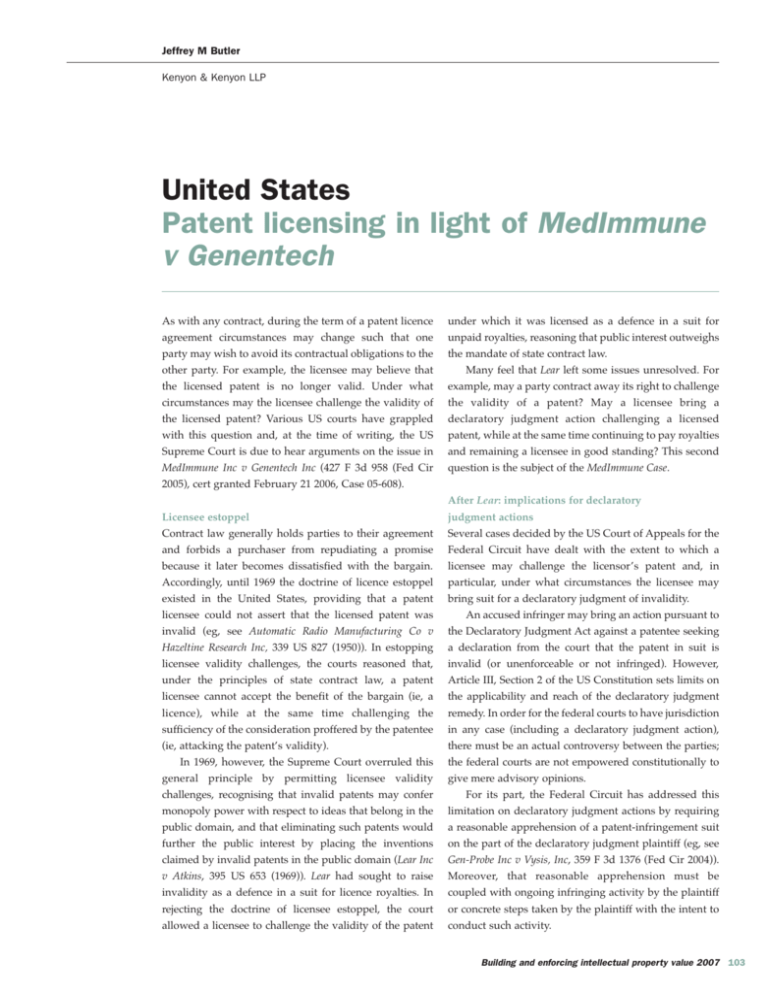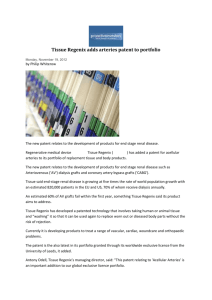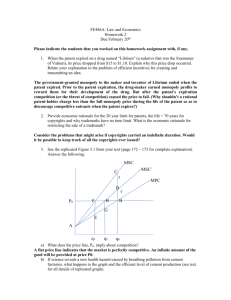United States Patent licensing in light of MedImmune v Genentech
advertisement

Jeffrey M Butler Kenyon & Kenyon LLP United States Patent licensing in light of MedImmune v Genentech As with any contract, during the term of a patent licence under which it was licensed as a defence in a suit for agreement circumstances may change such that one unpaid royalties, reasoning that public interest outweighs party may wish to avoid its contractual obligations to the the mandate of state contract law. other party. For example, the licensee may believe that Many feel that Lear left some issues unresolved. For the licensed patent is no longer valid. Under what example, may a party contract away its right to challenge circumstances may the licensee challenge the validity of the validity of a patent? May a licensee bring a the licensed patent? Various US courts have grappled declaratory judgment action challenging a licensed with this question and, at the time of writing, the US patent, while at the same time continuing to pay royalties Supreme Court is due to hear arguments on the issue in and remaining a licensee in good standing? This second MedImmune Inc v Genentech Inc (427 F 3d 958 (Fed Cir question is the subject of the MedImmune Case. 2005), cert granted February 21 2006, Case 05-608). After Lear: implications for declaratory Licensee estoppel judgment actions Contract law generally holds parties to their agreement Several cases decided by the US Court of Appeals for the and forbids a purchaser from repudiating a promise Federal Circuit have dealt with the extent to which a because it later becomes dissatisfied with the bargain. licensee may challenge the licensor’s patent and, in Accordingly, until 1969 the doctrine of licence estoppel particular, under what circumstances the licensee may existed in the United States, providing that a patent bring suit for a declaratory judgment of invalidity. licensee could not assert that the licensed patent was An accused infringer may bring an action pursuant to invalid (eg, see Automatic Radio Manufacturing Co v the Declaratory Judgment Act against a patentee seeking Hazeltine Research Inc, 339 US 827 (1950)). In estopping a declaration from the court that the patent in suit is licensee validity challenges, the courts reasoned that, invalid (or unenforceable or not infringed). However, under the principles of state contract law, a patent Article III, Section 2 of the US Constitution sets limits on licensee cannot accept the benefit of the bargain (ie, a the applicability and reach of the declaratory judgment licence), while at the same time challenging the remedy. In order for the federal courts to have jurisdiction sufficiency of the consideration proffered by the patentee in any case (including a declaratory judgment action), (ie, attacking the patent’s validity). there must be an actual controversy between the parties; In 1969, however, the Supreme Court overruled this general principle by permitting licensee validity the federal courts are not empowered constitutionally to give mere advisory opinions. challenges, recognising that invalid patents may confer For its part, the Federal Circuit has addressed this monopoly power with respect to ideas that belong in the limitation on declaratory judgment actions by requiring public domain, and that eliminating such patents would a reasonable apprehension of a patent-infringement suit further the public interest by placing the inventions on the part of the declaratory judgment plaintiff (eg, see claimed by invalid patents in the public domain (Lear Inc Gen-Probe Inc v Vysis, Inc, 359 F 3d 1376 (Fed Cir 2004)). v Atkins, 395 US 653 (1969)). Lear had sought to raise Moreover, that reasonable apprehension must be invalidity as a defence in a suit for licence royalties. In coupled with ongoing infringing activity by the plaintiff rejecting the doctrine of licensee estoppel, the court or concrete steps taken by the plaintiff with the intent to allowed a licensee to challenge the validity of the patent conduct such activity. Building and enforcing intellectual property value 2007 103 United States Kenyon & Kenyon LLP Declaratory judgments of invalidity in the patent similar facts, came before the Federal Circuit. In reliance licensing context on the Gen-Probe precedent, the court concluded that a In a number of cases the Federal Circuit has held that, if a reasonable apprehension of suit could not exist if the licensee does not materially breach the licence, there is no licensee remained in good standing. In other words, the jurisdiction for a declaratory judgment action – the licence Federal Circuit reiterated the holding that, before a protects the licensee from suit so that it cannot have a licensee can challenge the patent under which it is reasonable apprehension of the suit. However, there is licensed, it must commit material breach of the licence some debate as to whether such a holding is in accordance (eg, by ceasing payment of royalties) and put itself at risk with the precedent set by other circuit courts in decisions of an infringement suit. rendered before 1982. To the surprise of some, the Supreme Court agreed to In CR Bard Inc v Schwartz (716 F 2d 874 (Fed Cir 1983)) review the Federal Circuit’s decision. This gives the the patentee, Schwartz, sued Bard, the licensee, in the state Supreme Court an opportunity to evaluate the Federal courts for various breaches of the licensing contract. Bard Circuit’s approach in view of the policy concerns subsequently brought a federal suit under the Declaratory expressed in Lear, and perhaps ultimately redefine the Judgment Act to have the licensed patent declared invalid. scope of the actual controversy requirement in the Before commencement of the federal suit, Bard had context of a patent licence. stopped paying royalties to Schwartz, but the licence Genentech owns the Cabilly I patent and its agreement was not terminated. Examining all the continuation, Cabilly II, both of which are licensed to circumstances, the federal court determined that a MedImmune. The parties negotiated the licence in 1997 controversy sufficient for Bard to bring suit existed. By while the Cabilly II patent was involved in a lengthy failing to pay royalties, Bard had materially breached the interference proceeding involving the earlier-filed Boss agreement and, even though neither party had terminated patent, owned by Celltech. The US Patent and Trademark the licence, it no longer insulated Bard from an Office (USPTO) had granted Boss priority. Ultimately, infringement suit brought by Schwartz. Furthermore, the Genentech and Celltech settled their differences by fact that Schwartz had previously sued Bard demonstrated agreeing to an arrangement whereby Cabilly II would be that he was willing to bring suit to protect his patent rights. considered to have priority over Boss (later revoked), Thus, Bard had a reasonable apprehension of suit which and Celltech would receive a share of the royalties from satisfied the actual controversy requirement. the new patent (Cabilly II). Eleven years after the USPTO By the time the Federal Circuit decided the Gen-Probe Case, the material breach prerequisite had become declared an interference, the Cabilly II patent finally issued in 2001. established law in the Federal Circuit. Gen-Probe, the A significant portion of MedImmune’s business comes licensee, and Vysis, the patentee, had been opposing from sales of Synagis, a monoclonal antibody developed parties in several prior litigations. While negotiating a to combat an infectious respiratory tract disease in infants. settlement to those litigations, Vysis informed Gen-Probe After Cabilly II issued, Genentech notified MedImmune of newly issued US Patent 5,750,338 (the ‘338 patent). To that Cabilly II covered the Synagis product and that, under avoid an infringement suit, as part of the settlement with their licence agreement, MedImmune owed royalties with Vysis Gen-Probe entered into a licence agreement covering respect to its sales of that product. Although MedImmune the ’338 patent. Six months after Vysis granted the licence, reportedly felt that Synagis was not covered by Gen-Probe filed a declaratory judgment suit challenging Genentech’s patent and that the patent was invalid, it the validity of the patent. In a letter notifying Vysis of the elected to protect itself from an infringement suit suit, Gen-Probe stated its intention to continue paying involving its key product by paying the requested royalties in accordance with the licence until the resolution royalties, albeit “under protest”. Despite making the of the litigation. Throughout the court proceedings, the payments, MedImmune attempted to bring suit against licence agreement remained in effect, protecting Gen-Probe Genentech for a declaratory judgment of patent invalidity. from an infringement suit. On these facts the court However, applying Federal Circuit law, particularly Gen- concluded that no reasonable apprehension of suit existed Probe, the court held that MedImmune, as a licensee in and, therefore, the requirement of an actual controversy good standing, lacked a reasonable apprehension of suit, was not satisfied. Thus, Gen-Probe was not entitled to a and thus the courts could not properly adjudicate the declaration as to the licensed patent’s validity. declaratory judgment action. The MedImmune Case Licensee’s dilemma Shortly after Gen-Probe, MedImmune, a case with quite Does the actual controversy requirement of the Declaratory 104 Building and enforcing intellectual property value 2007 Kenyon & Kenyon LLP United States Judgment Act (28 USC Section 2201(a)) require a material example, consider the case of a start-up company that breach of a licence agreement by a licensee prior to suit for takes a licence from a patentee with greater leverage in declaratory relief for patent infringement, invalidity or order to avoid litigation involving the start-up’s new unenforceability? product. If that start-up later concludes that the In evaluating the dismissal of MedImmune’s underlying patent is invalid, and if the licence royalties declaratory judgment action, the Supreme Court will amount to a substantial tax on the start-up, the continued confront the issue of whether – under the Declaratory royalty payments on the invalid patent may hinder the Judgment Act and in accordance with the requirements of start-up’s ability to introduce its product or adversely Article III of the Constitution – a licensee in good standing affect the price of that product to the detriment of the may sue for a declaratory judgment. The existing legal public. If a licensee must materially breach its licence and standard, which requires the licensee to commit a material put itself at risk of an infringement suit before breach and not be in good standing in order to bring such challenging the patent’s validity, licensees such as this a suit, places a licensee in a dilemma. If the licensee hypothetical start-up may only rarely challenge those believes the licensed patent is invalid, it either can potentially invalid patents. continue to pay homage to the patentee by paying In MedImmune, in which Synagis is MedImmune’s royalties, thus avoiding the risk of an infringement suit, or biggest-selling product accounting for around half of the can jeopardise the licence by materially breaching it and company’s total sales, the risk of an infringement suit bring a declaratory judgment action. But it cannot have it (and the damages and injunctions that could result if it both ways – at least not under current law. If the Supreme were not to prevail in that suit) may be too great for the Court upholds the Federal Circuit’s Gen-Probe doctrine, company to accept. MedImmune also seems to be taking which the Federal Circuit followed in its MedImmune the position that the Gen-Probe line of cases, which decisions, thus requiring material breach, the dilemma requires a material breach by the licensee before a will remain a reality for patent licensees in the United declaratory judgment of invalidity may be sought and States. On the other hand, if the Supreme Court rules that obtained, is contrary to Lear and inconsistent with the a licensee may constitutionally bring such a suit without precedent of other circuits. first having to breach the licence agreement materially, the In MedImmune a number of entities have filed non- dilemma will mostly disappear, and instead licensees will party (amicus curiae) briefs. Among these is one from the be given the power to pick and choose if and when to solicitor general, on behalf of the United States, which attack the licensed patent. supports MedImmune and stresses the need for a more Many feel that permitting licensees to have that efficient mechanism to act as a check on weak patents. power by reversing MedImmune may ultimately hamper The non-parties assert that allowing licensees in good patent licensing in the United States; licensors may be standing to challenge such patents in an adversarial less willing to grant patent licences if they believe that proceeding (eg, in a declaratory judgment action) would their licensees – which often are in a unique position to be beneficial. Some argue that increasing numbers of challenge the patent – not only may face little risk if they weak patents have issued that should be freely do so, but may even be incentivised to do so. A licence challengeable by those with the greatest economic interest agreement would essentially be an insurance policy. If a to do so, namely licensees. The Supreme Court in Lear declaratory judgment suit were unsuccessful, the licence recognised the strong public interest in eliminating agreement would remain in effect and the licensee could invalid patents and the fact that licensees are often in the continue practising the patent on the previously best economic position to further that interest. Some also negotiated terms – that is, after an unsuccessful suit the argue that licensees that have taken a licence under a royalties called for in the licence agreement would group of patents (eg, a pool licence) should not be obliged basically cap the downside. It is also possible that more to breach the licence agreement and place themselves at litigation would result if MedImmune were reversed (due risk of an infringement claim under all the pooled patents primarily to an increase in licensee challenges), and that if they wish to challenge the validity of single patent. in turn could result in the need for licensors to demand This is by no means a one-sided debate; there are higher royalties since there is a greater risk of increased substantial arguments that militate towards the court’s costs on the part of the licensor. endorsing the Gen-Probe doctrine. For example, by On the other hand, it could be argued that barring a bringing a successful declaratory judgment action to licensee in good standing from bringing a suit invalidate a licensed patent, the licensee can essentially challenging the validity of the licensed patent may, in avoid the obligations for which it bargained. Is such a some instances, produce an inequitable result. For one-sided escape clause in the public’s best interests? Building and enforcing intellectual property value 2007 105 United States Kenyon & Kenyon LLP Allowing licensees to avoid their obligations may changed circumstances, namely the grant of the Cabilly II introduce uncertainty into the negotiation of future patent after the negotiation of the licence. MedImmune licences. It may even act as a disincentive on the part of could argue that, due to the agreement between Celltech patentees to grant licences, which in turn could and Genentech that resulted in the issue of the Cabilly II adversely affect the exploitation of new inventions. patent, the patentee extended the monopoly for the patented technology by 12 years. Does this constitute a Comment changed circumstance that warrants the licensee’s When the Supreme Court decides MedImmune it will challenge to the validity of the Cabilly II patent? presumably address the actual controversy requirement If the Supreme Court follows the Federal Circuit’s of the Declaratory Judgment Act. The court may interpret Gen-Probe (and MedImmune) approach and holds that a that requirement more broadly than has been the case in reasonable apprehension of suit is necessary, and that it the past. However, if threat of a suit is not a prerequisite, is not possible for a licensee in good standing to possess it potentially may be difficult to define ‘actual such apprehension reasonably, this distinction will not controversy’ in a way that limits declaratory judgment matter. However the Supreme Court decides the case, plaintiffs to actual licensees (ie, to exclude the possibility there will have been a healthy public debate regarding of having a third party seek a declaratory judgment to whether the Gen-Probe doctrine (and, for that matter, the challenge the validity of a licensed patent which may Lear doctrine) is good public policy – does it elicit an affect its business). The court may also decide that the effective and economical check on patent validity requirement is met in cases where the parties’ respective challenges, particularly with respect to assailable positions changed after the grant of the licence and this patents, and does it maintain a proper balance of risk change unfairly affects the licensee. For instance, it could between the licensee and the licensor in a way that be argued that MedImmune was unfairly affected by promotes and enhances the licensing of US patents? Jeffrey is an attorney at law and a registered patent attorney with extensive experience in litigation and adversarial matters concerning all aspects of intellectual property, including patents, trademarks, copyright, antitrust, unfair competition and trade secrets. He also has significant experience in domestic and international IP licensing, acquisition and exploitation. Jeffrey holds a JD from George Washington University. He has authored and coauthored articles and presented papers, seminars and symposia on numerous IP and litigation topics. Jeffrey gratefully acknowledges the contributions of Michele Y Antis and Joseph Zihal, associate and summer associate respectively at Kenyon & Kenyon. 106 Building and enforcing intellectual property value 2007 Jeffrey M Butler Partner, New York Tel +1 212 908 6040 Email jbutler@kenyon.com Kenyon & Kenyon LLP United States




